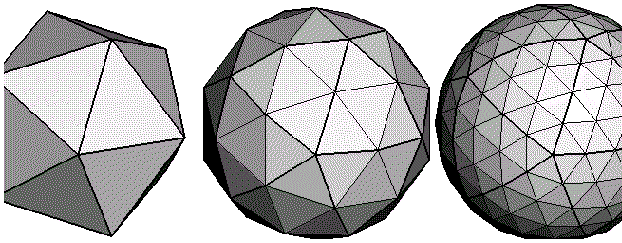Un exemple qui construit un isocahèdre |
  
|

#define X .525731112113133606
#define Z .850650808352039932
GLfloat d1[3], d2[3], norm[3];
static GLfloat vdata[12][3] = {
{-X, 0.0, Z},{X, 0.0, Z},{-X, 0.0, -Z},{X, 0.0, Z},
{0.0, Z, X},{0.0, Z, -X},{0.0, -Z, X},{0.0, -Z, -X},
{Z, X, 0.0},{-Z, X, 0.0},{Z, -X, 0.0},{-Z, -X, 0.0}
}
static GLint tindices[20][3] = {
{0, 4, 1}, {0, 9, 4}, {9, 5, 4}, {4, 5, 8}, {4, 8, 1},
{8, 10, 1}, {8, 3, 10}, {5, 3, 8}, {5, 2, 3}, {2, 7, 3},
{7, 10, 3}, {7, 6, 10}, {7, 11, 6}, {11, 0, 6}, {0, 1, 6},
{6, 1, 10}, {9, 0, 11}, {9, 11, 2}, {9, 2, 5}, {7, 2, 11}}
}
...
for(i = 0; i < 20; i++) {
/* Positionner les couleurs ici */
glBegin(GL_TRIANGLE);
glVertex3fv(&vdata[tindices[i][0][0]);
glVertex3fv(&vdata[tindices[i][1][0]);
glVertex3fv(&vdata[tindices[i][2][0]);
glEnd();
